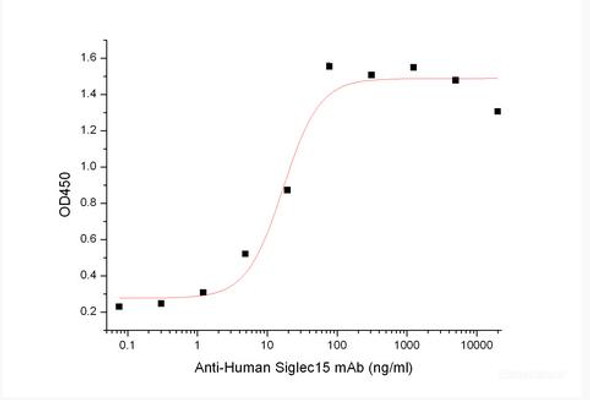Description
| Product Name: | Recombinant Cynomolgus Sialic acid-binding Ig-like lectin 15/Siglec-15/CD33L3 (C-6His) |
| Product Code: | RPES6768 |
| Size: | 10µg |
| Species: | Cynomolgus macaques |
| Expression Host: | HEK293 Cells |
| Synonyms: | Angiopoietin-related protein 4, 425O18-1, Angiopoietin-like protein 4, Fasting-induced adipose factor, Hepatic fibrinogen/angiopoietin-related protein, HFARP, Secreted protein Bk89, Angptl4, Farp, Fiaf, Ng27 |
| Mol Mass: | 27.1 kDa |
| AP Mol Mass: | 30-40 kDa |
| Tag: | C-6His |
| Purity: | > 95 % as determined by reducing SDS-PAGE. |
| Endotoxin Level: | < 1.0 EU per μg of the protein as determined by the LAL method. |
| Bio Activity: | Immobilized Cynomolgus Siglec-15-His at 2μg/ml (100 μl/well) can bind Anti-Human Siglec15 mAb. The ED50 of Anti-Human Siglec15 mAb is 125 ng/ml. |
| Sequence: | Phe20-Thr263 |
| Accession: | A0A2K5UY47 |
| Storage: | Generally, lyophilized proteins are stable for up to 12 months when stored at -20 to -80°C. Reconstituted protein solution can be stored at 4-8°C for 2-7 days. Aliquots of reconstituted samples are stable at < -20°C for 3 months. |
| Shipping: | This product is provided as lyophilized powder which is shipped with ice packs. |
| Formulation: | Lyophilized from a 0.2 μm filtered solution of PBS, 150mM NaCl, 0.3% Chaps, 5% Trehalose, pH 7.4. Normally 5 % - 8 % trehalose, mannitol and 0.01% Tween80 are added as protectants before lyophilization. Please refer to the specific buffer informat |
| Reconstitution: | Please refer to the printed manual for detailed information. |
| Background: | Human Siglec-15 is a transmembrane glycoprotein in the Siglec family. Siglecs are type I transmembrane proteins where the NH3+-terminus is in the extracellular space and the COO−-terminus is cytosolic. Each Siglec contains an N-terminal V-type immunoglobulin domain (Ig domain) which acts as the binding receptor for sialic acid. These lectins are placed into the group of I-type lectins because the lectin domain is an immunoglobulin fold. All Siglecs are extended from the cell surface by C2-type Ig domains which have no binding activity. Siglecs differ in the number of these C2-type domains. Human Siglec-15 consists of a 244 amino acid (aa) extracellular domain (ECD) with two Ig-like domains, a 21 aa transmembrane segment, and a 44 aa cytoplasmic domain. Siglec-15 function is important for osteoclast formation and TRANCE/RANK Ligand signaling in osteoclasts. |






